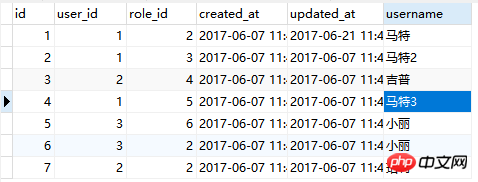資料表之間是縱橫交叉、相互關聯的,laravel的一對一,一對多比較好理解,官網介紹滴很詳細了,在此我就不贅述啦,重點我記下多對多的關係
一種常見的關聯關係是多對多,即表A的某筆記錄透過中間表C與表B的多筆記錄關聯,反之亦然。例如一個使用者有多種角色,反之一個角色對應多個使用者。
為了測試此關聯關係,我們沿用官網的使用者角色範例:
需要三個資料表:users、roles 和 role_user,role_user 表依照關聯模型名稱的字母順序命名(這裡role_user是中間表),並且包含 user_id 和 role_id兩個欄位。
多重對多重關聯是透過編寫傳回 belongsToMany 方法傳回結果的方法來定義。廢話不說多,直接上資料結構:
1:建立一個角色表roles,並且加入一些初始化資料:
SET FOREIGN_KEY_CHECKS=0;
-- ----------------------------
-- Table structure for users
-- ----------------------------
DROP TABLE IF EXISTS `users`;
CREATE TABLE `users` (
`id` int(10) unsigned NOT NULL AUTO_INCREMENT,
`name` varchar(255) COLLATE utf8_unicode_ci NOT NULL,
`email` varchar(255) COLLATE utf8_
(60) COLLATE utf8_unicode_ci NOT NULL,
`remember_token` varchar(100) COLLATE utf8_unicode_ci DEFAULT NULL,
`created_at` timestamp NOT NULL DEFAULT NULL,
`created_at` timestamp NOT NULL DEFAULT '000 updated_at` timestamp NOT NULL DEFAULT '0000-00-00 00:00:00',
PRIMARY KEY (`id`),
UNIQUE KEY `users_email_unique` (`eBTREE`) US REEUNIQUE KEY `users_email_unique` (`eBTREE`) USINE =InnoDB AUTO_INCREMENT=4 DEFAULT CHARSET=utf8 COLLATE=utf8_unicode_ci;
-- Records of users
-- ----------------------------------------##INSERT INTO `users` VALUES ( '1', 'admin', 'admin@163.com', '$2y$10$J/yXqscucanrHAGZp9G6..Tu1Md.SOljX3M8WrHsUdrgat4zeSuhC', 'ilocXtjZJwhrmIdLG1cKdrgat4zeSuhC', 'ilocXtjZJwhrmIdLG1cKy5,57p 16-04-21 16:26:23', '2016 -12-14 09:29:59');
INSERT INTO `users` VALUES ('2', 'baidu', '10940370@qq.com', '$2y$10$2A5zJ4pnJ5uCp1DN3.com', '$2y$10$2A5zJ4pnJ5uCp1DN3 ', null, '2016-04-22 06:48:10', '2016-04-22 06:48:10');
INSERT INTO `users` VALUES ('3', 'fantasy', ' 1009@qq.com', '', null, '2017-06-14 10:38:57', '2017-06-15 10:39:01');
,並且加入一些初始化資料:
-- ---------- ------------------
-- Table structure for roles-- ------------------ ----------
DROP TABLE IF EXISTS `roles`;
CREATE TABLE `roles` (
`id` int(10) unsigned NOT NULL AUTO_INCREMENT,
`name ` varchar(255) COLLATE utf8_unicode_ci NOT NULL,
`created_at` timestamp NOT NULL DEFAULT '0000-00-00 00:00:00',
00updated_at` timest NOT NM :00:00',
PRIMARY KEY (`id`)
) ENGINE=InnoDB AUTO_INCREMENT=7 DEFAULT CHARSET=utf8 COLLATE=utf8_unicode_ci;
#-- -------- --------------------
------------------- -----------
INSERT INTO `roles` VALUES ('1', '超級版主', '2016-04-21 16:26:23', '2016-12-14 09:29:59');
INSERT INTO `roles` VALUES ('2', '司令', '2016-04-22 06:48:10', '2016-04-22 06:48:10 ');
INSERT INTO `roles` VALUES ('3', '軍長', '2017-06-14 10:38:57', '2017-06-15 10:39:01');
INSERT INTO `roles` VALUES ('4', '司長', '2017-06-07 10:41:41', '2017-06-15 10:41:51');
INSERT INTO `roles` VALUES ('5', '團戰', '2017-06-22 10:41:44', '2017-06-28 10:41:54');
INSERT INTO `roles` VALUES ('6', '小兵', '2017-06-22 10:41:47', '2017-06-22 10:41:56');
用於記錄users表格與roles表的對應關係,並加入一些初始化資料:
SET FOREIGN_KEY_CHECKS=0;-- ------------------------------ Table structure for role_user-- ----------------------------DROP TABLE IF EXISTS `role_user`;CREATE TABLE `role_user` (
`id` int(10) unsigned NOT NULL AUTO_INCREMENT,
`user_id` int(11) DEFAULT NULL,
`role_id` int(11) DEFAULT NULL,
`created_at` datetime DEFAULT NULL,
`updated_at` datetime DEFAULT NULL, PRIMARY KEY (`id`)
) ENGINE=MyISAM AUTO_INCREMENT=8 DEFAULT CHARSET=latin1;-- ------------------------------ Records of role_user-- ----------------------------INSERT INTO `role_user` VALUES ('1', '1', '2', '2017-06-07 11:42:13', '2017-06-21 11:32:16');INSERT INTO `role_user` VALUES ('2', '1', '3', '2017-06-07 11:32:13', '2017-06-07 11:22:13');INSERT INTO `role_user` VALUES ('3', '2', '4', '2017-06-07 11:32:13', '2017-06-07 11:12:13');INSERT INTO `role_user` VALUES ('4', '1', '5', '2017-06-07 11:32:13', '2017-06-07 11:22:13');INSERT INTO `role_user` VALUES ('5', '3', '6', '2017-06-07 11:32:13', '2017-06-07 11:52:13');INSERT INTO `role_user` VALUES ('6', '3', '2', '2017-06-07 11:32:13', '2017-06-07 11:42:13');INSERT INTO `role_user` VALUES ('7', '2', '2', '2017-06-07 11:42:13', '2017-06-07 11:52:13');建立一個
Role模型:
<?php
namespace App\Models;use Illuminate\Database\Eloquent\Model;/**
* Class Role
* @package App\Models
* @mixin \Eloquent */class Role extends Model
{
}然后我们在 User 模型上定义 roles 方法:
<?php
namespace App\Models;use Illuminate\Database\Eloquent\Model;/**
* Class User
* @package App\Models
* @mixin \Eloquent */class User extends Model
{/**
* 用户角色 */public function roles()
{return $this->belongsToMany('App\Models\Role');
}
}注:正如我们上面提到的,如果中间表不是role_user,那么需要将中间表作为第二个参数传入belongsToMany方法,如果中间表中的字段不是user_id和role_id,这里我们姑且将其命名为$user_id和$role_id,那么需要将$user_id作为第三个参数传入该方法,$role_id作为第四个参数传入该方法,如果关联方法名不是roles还可以将对应的关联方法名作为第五个参数传入该方法。
接下来我们在控制器中编写测试代码:
<? = User::find(1 = -> '用户'.->name.'所拥有的角色:'( ->name.' '; //对应输出为:用户admin所拥有的角色:司令 军长 团战
当然,和所有其它关联关系类型一样,你可以调用roles 方法来添加条件约束到关联查询上:
User::find(1)->roles()->orderBy('name')->get();正如前面所提到的,为了确定关联关系连接表的表名,Eloquent 以字母顺序连接两个关联模型的名字。不过,你可以重写这种约定 —— 通过传递第二个参数到 belongsToMany 方法:
return $this->belongsToMany('App\Models\Role', 'user_roles');除了自定义连接表的表名,你还可以通过传递额外参数到 belongsToMany 方法来自定义该表中字段的列名。第三个参数是你定义关联关系模型的外键名称,第四个参数你要连接到的模型的外键名称:
return $this->belongsToMany('App\Models\Role', 'user_roles', 'user_id', 'role_id');定义相对的关联关系
要定义与多对多关联相对的关联关系,只需在关联模型中调用一下 belongsToMany 方法即可。我们在 Role 模型中定义 users 方法:
<?php
namespace App\Models;use Illuminate\Database\Eloquent\Model;/**
* Class Role
* @package App\Models
* @mixin \Eloquent */class Role extends Model
{/**
* 角色用户 */public function users()
{return $this->belongsToMany('App\Models\User');
}
} 正如你所看到的,定义的关联关系和与其对应的User 中定义的一模一样,只是前者引用 App\Models\Role,后者引用App\Models\User,由于我们再次使用了 belongsToMany 方法,所有的常用表和键自定义选项在定义与多对多相对的关联关系时都是可用的。
测试代码如下:
= Role::find(2 = -> '角色#'.->name.'下面的用户:' ( ->name.' '
正如你看到的,处理多对多关联要求一个中间表。Eloquent 提供了一些有用的方法来与这个中间表进行交互,例如,我们假设 User 对象有很多与之关联的 Role 对象,访问这些关联关系之后,我们可以使用这些模型上的pivot 属性访问中间表字段:
= User::find(1)-> ( ->pivot->role_id.'<br>'
注意我们获取到的每一个 Role 模型都被自动赋上了 pivot 属性。该属性包含一个代表中间表的模型,并且可以像其它 Eloquent 模型一样使用。
默认情况下,只有模型主键才能用在 pivot 对象上,如果你的 pivot 表包含额外的属性,必须在定义关联关系时进行指定:
return $this->belongsToMany('App\Models\Role')->withPivot('column1', 'column2');比如我们修改role_user表增加一个字段 username 数据如下:
修改模型User:
<?php
namespace App\Models;use Illuminate\Database\Eloquent\Model;/**
* Class User
* @package App\Models
* @mixin \Eloquent */class User extends Model
{/**
* 用户角色 */public function roles()
{//return $this->belongsToMany('App\Models\Role');return $this->belongsToMany('App\Models\Role')->withPivot('username');
}
}测试代码如下:
= User::find(1 (->roles ->pivot->
如果你想要你的 pivot 表自动包含created_at 和 updated_at 时间戳,在关联关系定义时使用 withTimestamps 方法:
return $this->belongsToMany('App\Models\Role')->withTimestamps();通过中间表字段过滤关联关系
你还可以在定义关联关系的时候使用 wherePivot 和 wherePivotIn 方法过滤belongsToMany 返回的结果集:
return $this->belongsToMany('App\Models\Role')->withPivot('username')->wherePivot('username', '马特2');//return $this->belongsToMany('App\Models\Role')->wherePivotIn('role_id', [1, 2]);测试代码如下:
$user = User::find(1);print_r($user->roles->toArray());
以上对应输出:
Array ( [0] => Array ( [id] => 3[name] => 军长 [created_at] => 2017-06-14 10:38:57[updated_at] => 2017-06-15 10:39:01[pivot] => Array ( [user_id] => 1[role_id] => 3[username] => 马特2 ) ) )
如果你想要你的pivot表自动包含created_at和updated_at时间戳,在关联关系定义时使用withTimestamps方法:
return $this->belongsToMany('App\Models\Role')->withTimestamps();这一节我先讲到这里啦,下一节我将讨论更复杂的三种关联关系及其在模型中的定义及使用。未完待续...
以上是laravel中常見的關聯關係--多對多的詳細內容。更多資訊請關注PHP中文網其他相關文章!




